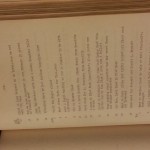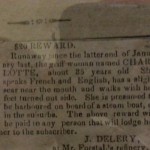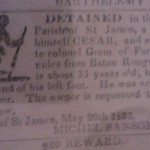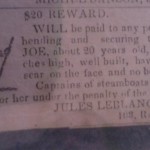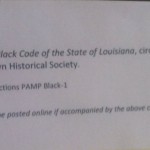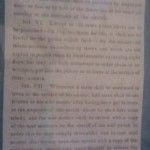DENVER’S SECRETS were sweet. Accompanied every time by wild veronica until she
discovered cologne. The first bottle was a gift, the next she stole from her
mother and hid among boxwood until it froze and cracked. That was the year
winter came in a hurry at suppertime and stayed eight months. One of the War
years when Miss Bodwin, the whitewoman, brought Christmas cologne for her
mother and herself, oranges for the boys and another good wool shawl for Baby
Suggs. Talking of a war full of dead people, she looked happy–flush-faced, and
although her voice was heavy as a man’s, she smelled like a roomful of
flowers–excitement that Denver could have all for herself in the boxwood. Back
beyond 1×4 was a narrow field that stopped itself at a wood. On the yonder side
of these woods, a stream.
In these woods, between the field and the stream, hidden by post oaks,
five boxwood bushes, planted in a ring, had started stretching toward each
other four feet off the ground to form a round, empty room seven feet high, its
walls fifty inches of murmuring leaves.
Bent low, Denver could crawl into this room, and once there she could
stand all the way up in emerald light.
It began as a little girl’s houseplay, but as her desires changed, so did
the play. Quiet, primate and completely secret except for the noisome cologne
signal that thrilled the rabbits before it confused them. First a playroom
(where the silence was softer), then a refuge (from her brothers’ fright), soon
the place became the point. In that bower, closed off from the hurt of the hurt
world, Denver’s imagination produced its own hunger and its own food, which she
badly needed because loneliness wore her out. Wore her out. Veiled and
protected by the live green walls, she felt ripe and clear, and salvation was
as easy as a wish.Once when she was in the boxwood, an autumn long before Paul D moved into
the house with her mother, she was made suddenly cold by a combination of wind
and the perfume on her skin. She dressed herself, bent down to leave and stood
up in snowfall: a thin and whipping snow very like the picture her mother had
painted as she described the circumstances of Denver’s birth in a canoe
straddled by a whitegirl for whom she was named.
Shivering, Denver approached the house, regarding it, as she always did,
as a person rather than a structure. A person that wept, sighed, trembled and
fell into fits. Her steps and her gaze were the cautious ones of a child
approaching a nervous, idle relative (someone dependent but proud). A
breastplate of darkness hid all the windows except one. Its dim glow came from
Baby Suggs’ room. When Denver looked in, she saw her mother on her knees in
prayer, which was not unusual. What was unusual (even for a girl who had lived
all her life in a house peopled by the living activity of the dead) was that a
white dress knelt down next to her mother and had its sleeve around her
mother’s waist. And it was the tender embrace of the dress sleeve that made
Denver remember the details of her birth–that and the thin, whipping snow she
was standing in, like the fruit of common flowers. The dress and her mother
together looked like two friendly grown-up women–one (the dress) helping out
the other.
And the magic of her birth, its miracle in fact, testified to that
friendliness as did her own name.
Easily she stepped into the told story that lay before her eyes on the
path she followed away from the window. There was only one door to the house
and to get to it from the back you had to walk all the way around to the front
of 124, past the storeroom, past the cold house, the privy, the shed, on around
to the porch. And to get to the part of the story she liked best, she had to
start way back: hear the birds in the thick woods, the crunch of leaves
underfoot; see her mother making her way up into the hills where no houses were
likely to be. How Sethe was walking on two feet meant for standing still. How
they were so swollen she could not see her arch or feel her ankles. Her leg
shaft ended in a loaf of flesh scalloped by five toenails. But she could not,
would not, stop, for when she did the little antelope rammed her with horns and
pawed the ground of her womb with impatient hooves. While she was walking, it
seemed to graze, quietly–so she walked, on two feet meant, in this sixth month
of pregnancy, for standing still. Still, near a kettle; still, at the churn;
still, at the tub and ironing board. Milk, sticky and sour on her dress,
attracted every small flying thing from gnats to grasshoppers.
By the time she reached the hill skirt she had long ago stopped waving
them off. The clanging in her head, begun as a churchbell heard from a
distance, was by then a tight cap of pealing bells around her ears. She sank
and had to look down to see whether she was in a hole or kneeling. Nothing was
alive but her nipples and the little antelope. Finally, she was horizontal–or
must have been because blades of wild onion were scratching her temple and her
cheek. Concerned as she was for the life of her children’s mother, Sethe told
Denver, she remembered thinking: “Well, at least I don’t have to take another
step.” A dying thought if ever there was one, and she waited for the little
antelope to protest, and why she thought of an antelope Sethe could not imagine
since she had never seen one. She guessed it must have been an invention held
on to from before Sweet Home, when she was very young. Of that place where she
was born (Carolina maybe? or was it Louisiana?) she remembered only song and
dance. Not even her own mother, who was pointed out to her by the eight-yearold child who watched over the young ones–pointed out as the one among many
backs turned away from her, stooping in a watery field. Patiently Sethe waited
for this particular back to gain the row’s end and stand. What she saw was a
cloth hat as opposed to a straw one, singularity enough in that world of cooing
women each of whom was called Ma’am.”Seth–thuh.”
“Ma’am.”
“Hold on to the baby.”
“Yes, Ma’am.”
“Seth–thuh.”
“Ma’am.”
“Get some kindlin in here.”
“Yes, Ma’am.”
Oh but when they sang. And oh but when they danced and sometimes they
danced the antelope. The men as well as the ma’ams, one of whom was certainly
her own. They shifted shapes and became something other. Some unchained,
demanding other whose feet knew her pulse better than she did. Just like this
one in her stomach.
“I believe this baby’s ma’am is gonna die in wild onions on the bloody
side of the Ohio River.” That’s what was on her mind and what she told Denver.
Her exact words. And it didn’t seem such a bad idea, all in all, in view of the
step she would not have to take, but the thought of herself stretched out dead
while the little antelope lived on–an hour? a day? a day and a night?–in her
lifeless body grieved her so she made the groan that made the person walking on
a path not ten yards away halt and stand right still. Sethe had not heard the
walking, but suddenly she heard the standing still and then she smelled the
hair. The voice, saying, “Who’s in there?” was all she needed to know that she
was about to be discovered by a white boy. That he too had mossy teeth, an
appetite. That on a ridge of pine near the Ohio River, trying to get to her
three children, one of whom was starving for the food she carried; that after
her husband had disappeared; that after her milk had been stolen, her back
pulped, her children orphaned, she was not to have an easeful death. No.
She told Denver that a something came up out of the earth into her–like
a freezing, but moving too, like jaws inside. “Look like I was just cold jaws
grinding,” she said. Suddenly she was eager for his eyes, to bite into them; to
gnaw his cheek.
“I was hungry,” she told Denver, “just as hungry as I could be for his
eyes. I couldn’t wait.”
So she raised up on her elbow and dragged herself, one pull, two, three,
four, toward the young white voice talking about “Who that back in there?”
” ‘Come see,’ I was thinking. ‘Be the last thing you behold,’ and sure
enough here come the feet so I thought well that’s where I’ll have to start God
do what He would, I’m gonna eat his feet off. I’m laughing now, but it’s true.
I wasn’t just set to do it. I was hungry to do it. Like a snake. All jaws and
hungry.
“It wasn’t no whiteboy at all. Was a girl. The raggediest-looking trash
you ever saw saying, ‘Look there. A nigger. If that don’t beat all.’ ”
And now the part Denver loved the best: Her name was Amy and she needed
beef and pot liquor like nobody in this world. Arms like cane stalks and enough
hair for four or five heads. Slow-moving eyes. She didn’t look at anything
quick.
Talked so much it wasn’t clear how she could breathe at the same time.
And those cane-stalk arms, as it turned out, were as strong as iron.
“You ’bout the scariest-looking something I ever seen. What you doing
back up in here?”
Down in the grass, like the snake she believed she was, Sethe opened her
mouth, and instead of fangs and a split tongue, out shot the truth.
“Running,” Sethe told her. It was the first word she had spoken all day
and it came out thick because of her tender tongue.
“Them the feet you running on? My Jesus my.” She squatted down and stared
at Sethe’s feet. “You got anything on you, gal, pass for food?”
“No.” Sethe tried to shift to a sitting position but couldn t.”I like to die I’m so hungry.” The girl moved her eyes slowly, examining
the greenery around her. “Thought there’d be huckleberries.
Look like it. That’s why I come up in here. Didn’t expect to find no
nigger woman. If they was any, birds ate em. You like huckleberries?”
“I’m having a baby, miss.”
Amy looked at her. “That mean you don’t have no appetite? Well I got to
eat me something.”
Combing her hair with her fingers, she carefully surveyed the landscape
once more. Satisfied nothing edible was around, she stood up to go and Sethe’s
heart stood up too at the thought of being left alone in the grass without a
fang in her head.
“Where you on your way to, miss?”
She turned and looked at Sethe with freshly lit eyes. “Boston. Get me
some velvet. It’s a store there called Wilson. I seen the pictures of it and
they have the prettiest velvet. They don’t believe I’m a get it, but I am.”
Sethe nodded and shifted her elbow. “Your ma’am know you on the lookout
for velvet?”
The girl shook her hair out of her face. “My mama worked for these here
people to pay for her passage. But then she had me and since she died right
after, well, they said I had to work for em to pay it off. I did, but now I
want me some velvet.”
They did not look directly at each other, not straight into the eyes
anyway. Yet they slipped effortlessly into yard chat about nothing in
particular–except one lay on the ground.
“Boston,” said Sethe. “Is that far?”
“Ooooh, yeah. A hundred miles. Maybe more.”
“Must be velvet closer by.”
“Not like in Boston. Boston got the best. Be so pretty on me.
You ever touch it?”
“No, miss. I never touched no velvet.” Sethe didn’t know if it was the
voice, or Boston or velvet, but while the whitegirl talked, the baby slept. Not
one butt or kick, so she guessed her luck had turned.
“Ever see any?” she asked Sethe. “I bet you never even seen any.”
“If I did I didn’t know it. What’s it like, velvet?”
Amy dragged her eyes over Sethe’s face as though she would never give out
so confidential a piece of information as that to a perfect stranger.
“What they call you?” she asked.
However far she was from Sweet Home, there was no point in giving out her
real name to the first person she saw. “Lu,” said Sethe.
“They call me Lu.”
“Well, Lu, velvet is like the world was just born. Clean and new and so
smooth. The velvet I seen was brown, but in Boston they got all colors.
Carmine. That means red but when you talk about velvet you got to say
‘carmine.’ ” She raised her eyes to the sky and then, as though she had wasted
enough time away from Boston, she moved off saying, “I gotta go.”
Picking her way through the brush she hollered back to Sethe, “What you
gonna do, just lay there and foal?”
“I can’t get up from here,” said Sethe.
“What?” She stopped and turned to hear.
“I said I can’t get up.”
Amy drew her arm across her nose and came slowly back to where Sethe lay.
“It’s a house back yonder,” she said.
“A house?”
“Mmmmm. I passed it. Ain’t no regular house with people in it though. A
lean-to, kinda.”
“How far?”
“Make a difference, does it? You stay the night here snake get you.””Well he may as well come on. I can’t stand up let alone walk and God
help me, miss, I can’t crawl.”
“Sure you can, Lu. Come on,” said Amy and, with a toss of hair enough for
five heads, she moved toward the path.
So she crawled and Amy walked alongside her, and when Sethe needed to
rest, Amy stopped too and talked some more about Boston and velvet and good
things to eat. The sound of that voice, like a sixteen-year-old boy’s, going on
and on and on, kept the little antelope quiet and grazing. During the whole
hateful crawl to the lean to, it never bucked once.
Nothing of Sethe’s was intact by the time they reached it except the
cloth that covered her hair. Below her bloody knees, there was no feeling at
all; her chest was two cushions of pins. It was the voice full of velvet and
Boston and good things to eat that urged her along and made her think that
maybe she wasn’t, after all, just a crawling graveyard for a six-month baby’s
last hours.
The lean-to was full of leaves, which Amy pushed into a pile for Sethe to
lie on. Then she gathered rocks, covered them with more leaves and made Sethe
put her feet on them, saying: “I know a woman had her feet cut off they was so
swole.” And she made sawing gestures with the blade of her hand across Sethe’s
ankles. “Zzz Zzz Zzz Zzz.”
“I used to be a good size. Nice arms and everything. Wouldn’t think it,
would you? That was before they put me in the root cellar.
I was fishing off the Beaver once. Catfish in Beaver River sweet as
chicken. Well I was just fishing there and a nigger floated right by me. I
don’t like drowned people, you? Your feet remind me of him.
All swole like.”
Then she did the magic: lifted Sethe’s feet and legs and massaged them
until she cried salt tears.
“It’s gonna hurt, now,” said Amy. “Anything dead coming back to life
hurts.”
A truth for all times, thought Denver. Maybe the white dress holding its
arm around her mother’s waist was in pain. If so, it could mean the baby ghost
had plans. When she opened the door, Sethe was just leaving the keeping room.
“I saw a white dress holding on to you,” Denver said.
“White? Maybe it was my bedding dress. Describe it to me.”
“Had a high neck. Whole mess of buttons coming down the back.”
“Buttons. Well, that lets out my bedding dress. I never had a button on
nothing.”
“Did Grandma Baby?”
Sethe shook her head. “She couldn’t handle them. Even on her shoes. What
else?”
“A bunch at the back. On the sit-down part.”
“A bustle? It had a bustle?”
“I don’t know what it’s called.”
“Sort of gathered-like? Below the waist in the back?”
“Um hm.”
“A rich lady’s dress. Silk?”
“Cotton, look like.”
“Lisle probably. White cotton lisle. You say it was holding on to me.
How?”
“Like you. It looked just like you. Kneeling next to you while you were
praying. Had its arm around your waist.”
“Well, I’ll be.”
“What were you praying for, Ma’am?”
“Not for anything. I don’t pray anymore. I just talk.”
“What were you talking about?”
“You won’t understand, baby.””Yes, I will.”
“I was talking about time. It’s so hard for me to believe in it.
Some things go. Pass on. Some things just stay. I used to think it was my
rememory. You know. Some things you forget. Other things you never do. But it’s
not. Places, places are still there. If a house burns down, it’s gone, but the
place–the picture of it–stays, and not just in my rememory, but out there, in
the world. What I remember is a picture floating around out there outside my
head. I mean, even if I don’t think it, even if I die, the picture of what I
did, or knew, or saw is still out there. Right in the place where it happened.”
“Can other people see it?” asked Denver.
“Oh, yes. Oh, yes, yes, yes. Someday you be walking down the road and you
hear something or see something going on. So clear.
And you think it’s you thinking it up. A thought picture. But no. It’s
when you bump into a rememory that belongs to somebody else.
Where I was before I came here, that place is real. It’s never going
away. Even if the whole farm–every tree and grass blade of it dies.
The picture is still there and what’s more, if you go there–you who
never was there–if you go there and stand in the place where it was, it will
happen again; it will be there for you, waiting for you. So, Denver, you can’t
never go there. Never. Because even though it’s all over–over and done with–
it’s going to always be there waiting for you. That’s how come I had to get all
my children out. No matter what.”
Denver picked at her fingernails. “If it’s still there, waiting, that
must mean that nothing ever dies.”
Sethe looked right in Denver’s face. “Nothing ever does,” she said.
“You never told me all what happened. Just that they whipped you and you
run off, pregnant. With me.”
“Nothing to tell except schoolteacher. He was a little man. Short.
Always wore a collar, even in the fields. A schoolteacher, she said.
That made her feel good that her husband’s sister’s husband had book
learning and was willing to come farm Sweet Home after Mr.
Garner passed. The men could have done it, even with Paul F sold.
But it was like Halle said. She didn’t want to be the only white person
on the farm and a woman too. So she was satisfied when the schoolteacher agreed
to come. He brought two boys with him. Sons or nephews. I don’t know. They
called him Onka and had pretty man ners, all of em. Talked soft and spit in
handkerchiefs. Gentle in a lot of ways. You know, the kind who know Jesus by
His first name, but out of politeness never use it even to His face. A pretty
good farmer, Halle said. Not strong as Mr. Garner but smart enough. He liked
the ink I made. It was her recipe, but he preferred how I mixed it and it was
important to him because at night he sat down to write in his book. It was a
book about us but we didn’t know that right away. We just thought it was his
manner to ask us questions. He commenced to carry round a notebook and write
down what we said. I still think it was them questions that tore Sixo up. Tore
him up for all time.”
She stopped.
Denver knew that her mother was through with it–for now anyway. The
single slow blink of her eyes; the bottom lip sliding up slowly to cover the
top; and then a nostril sigh, like the snuff of a candle flame–signs that
Sethe had reached the point beyond which she would not go.
“Well, I think the baby got plans,” said Denver.
“What plans?”
“I don’t know, but the dress holding on to you got to mean something.”
“Maybe,” said Sethe. “Maybe it does have plans.”
Whatever they were or might have been, Paul D messed them up for good.
With a table and a loud male voice he had rid 124 of its claim to local fame.
Denver had taught herself to take pride in the condemnation Negroes heaped onthem; the assumption that the haunting was done by an evil thing looking for
more. None of them knew the downright pleasure of enchantment, of not
suspecting but knowing the things behind things. Her brothers had known, but it
scared them; Grandma Baby knew, but it saddened her. None could appreciate the
safety of ghost company. Even Sethe didn’t love it.
She just took it for granted–like a sudden change in the weather.
But it was gone now. Whooshed away in the blast of a hazelnut man’s
shout, leaving Denver’s world flat, mostly, with the exception of an emerald
closet standing seven feet high in the woods. Her mother had secrets–things
she wouldn’t tell; things she halfway told.
Well, Denver had them too. And hers were sweet–sweet as lily-of-thevalley cologne.
Sethe had given little thought to the white dress until Paul D came, and
then she remembered Denver’s interpretation: plans. The morning after the first
night with Paul D, Sethe smiled just thinking about what the word could mean.
It was a luxury she had not had in eighteen years and only that once. Before
and since, all her effort was directed not on avoiding pain but on getting
through it as quickly as possible. The one set of plans she had made–getting
away from Sweet Home–went awry so completely she never dared life by making
more.
Yet the morning she woke up next to Paul D, the word her daughter had
used a few years ago did cross her mind and she thought about what Denver had
seen kneeling next to her, and thought also of the temptation to trust and
remember that gripped her as she stood before the cooking stove in his arms.
Would it be all right? Would it be all right to go ahead and feel? Go ahead and
count on something?
She couldn’t think clearly, lying next to him listening to his breathing,
so carefully, carefully, she had left the bed.
Kneeling in the keeping room where she usually went to talk-think it was
clear why Baby Suggs was so starved for color. There wasn’t any except for two
orange squares in a quilt that made the absence shout. The walls of the room
were slate-colored, the floor earth-brown, the wooden dresser the color of
itself, curtains white, and the dominating feature, the quilt over an iron cot,
was made up of scraps of blue serge, black, brown and gray wool–the full range
of the dark and the muted that thrift and modesty allowed. In that sober field,
two patches of orange looked wild–like life in the raw.
Sethe looked at her hands, her bottle-green sleeves, and thought how
little color there was in the house and how strange that she had not missed it
the way Baby did. Deliberate, she thought, it must be deliberate, because the
last color she remembered was the pink chips in the headstone of her baby girl.
After that she became as color conscious as a hen. Every dawn she worked at
fruit pies, potato dishes and vegetables while the cook did the soup, meat and
all the rest. And she could not remember remembering a molly apple or a yellow
squash. Every dawn she saw the dawn, but never acknowledged or remarked its
color. There was something wrong with that.
It was as though one day she saw red baby blood, another day the pink
gravestone chips, and that was the last of it.
124 was so full of strong feeling perhaps she was oblivious to the loss
of anything at all. There was a time when she scanned the fields every morning
and every evening for her boys. When she stood at the open window, unmindful of
flies, her head cocked to her left shoulder, her eyes searching to the right
for them. Cloud shadow on the road, an old woman, a wandering goat untethered
and gnawing bramble–each one looked at first like Howard–no, Buglar. Little
by little she stopped and their thirteen-year-old faces faded completely into
their baby ones, which came to her only in sleep. When her dreams roamed
outside 124, anywhere they wished, she saw them sometimes in beautiful trees,
their little legs barely visible in the leaves.Sometimes they ran along the railroad track laughing, too loud,
apparently, to hear her because they never did turn around. When she woke the
house crowded in on her: there was the door where the soda crackers were lined
up in a row; the white stairs her baby girl loved to climb; the corner where
Baby Suggs mended shoes, a pile of which were still in the cold room; the exact
place on the stove where Denver burned her fingers. And of course the spite of
the house itself. There was no room for any other thing or body until Paul D
arrived and broke up the place, making room, shifting it, moving it over to
someplace else, then standing in the place he had made.
So, kneeling in the keeping room the morning after Paul D came, she was
distracted by the two orange squares that signaled how barren 124 really was.
He was responsible for that. Emotions sped to the surface in his company.
Things became what they were: drabness looked drab; heat was hot. Windows
suddenly had view. And wouldn’t you know he’d be a singing man.
Little rice, little bean,
No meat in between.
Hard work ain’t easy,
Dry bread ain’t greasy.
He was up now and singing as he mended things he had broken the day
before. Some old pieces of song he’d learned on the prison farm or in the War
afterward. Nothing like what they sang at Sweet Home, where yearning fashioned
every note.
The songs he knew from Georgia were flat-headed nails for pounding and
pounding and pounding.
Lay my bead on the railroad line,
Train come along, pacify my mind.
If I had my weight in lime,
I’d whip my captain till he went stone blind.
Five-cent nickel, Ten-cent dime,
Busting rocks is busting time.
But they didn’t fit, these songs. They were too loud, had too much power
for the little house chores he was engaged in–resetting table legs; glazing.
He couldn’t go back to “Storm upon the Waters” that they sang under the
trees of Sweet Home, so he contented himself with mmmmmmmmm, throwing in a line
if one occurred to him, and what occurred over and over was “Bare feet and
chamomile sap,/ Took off my shoes; took off my hat.”
It was tempting to change the words (Gimme back my shoes; gimme back my
hat), because he didn’t believe he could live with a woman–any woman–for over
two out of three months. That was about as long as he could abide one place.
After Delaware and before that Alfred, Georgia, where he slept underground and
crawled into sunlight for the sole purpose of breaking rock, walking off when
he got ready was the only way he could convince himself that he would no longer
have to sleep, pee, eat or swing a sledge hammer in chains.
But this was not a normal woman in a normal house. As soon as he had
stepped through the red light he knew that, compared to 124, the rest of the
world was bald. After Alfred he had shut down a generous portion of his head,
operating on the part that helped him walk, eat, sleep, sing. If he could do
those things–with a little work and a little sex thrown in–he asked for no
more, for more required him to dwell on Halle’s face and Sixo laughing. To
recall trembling in a box built into the ground. Grateful for the daylightspent doing mule work in a quarry because he did not tremble when he had a
hammer in his hands. The box had done what Sweet Home had not, what working
like an ass and living like a dog had not: drove him crazy so he would not lose
his mind.
By the time he got to Ohio, then to Cincinnati, then to Halle Suggs’
mother’s house, he thought he had seen and felt it all. Even now as he put back
the window frame he had smashed, he could not account for the pleasure in his
surprise at seeing Halle’s wife alive, barefoot with uncovered hair–walking
around the corner of the house with her shoes and stockings in her hands. The
closed portion of his head opened like a greased lock.
“I was thinking of looking for work around here.

